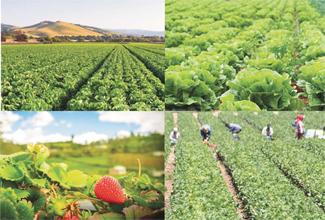Welcome to Blue Book!
Are you ready to join the thousands of companies who rely on Blue Book to drive smarter decisions? View our plans and get started today!
Still have questions? We’d love to show you what Blue Book can do for you. Drop us a line– we’ve been waiting for you.

Last summer, California’s coastal valleys near Santa Maria and Salinas experienced uncommonly warm nights, causing major headaches for growers in the region. “These very odd weather patterns wreaked complete havoc with almost all crops, stunting growth for long periods of time,” McDonald explains. He says this in turn led to extreme shortages and unusually high markets for an extended period of time.
The weird weather had a major impact on the lettuce category—less tonnage per acre resulted in a demand-exceeds-supply situation, with iceberg lettuce prices reaching over $20 per carton. Broccoli, cauliflower, and celery were affected as well, with a dearth of supply for weeks.
PESKY PESTS & DISEASES
Like most growing regions, pests and plant disease are an ever-present danger for Salinas farmers. “Many serious pests have manifested themselves locally, and this is an ongoing problem,” stresses Groot.
He adds that crop protection tools are highly restricted in California, so growers must utilize many integrated pest management practices in addition to chemical solutions. “Some of the newer, imported, or exotic pests have no natural enemies or chemical control measures, such as the Bagrada bug, which poses a very real threat to local production.”
Also called the painted bug, the Bagrada is a type of stink bug that attacks vegetables and is particularly devastating to young seedlings and leafy greens. The invasive pest was first discovered in Los Angeles County in 2008, spread throughout Southern California within three years and reached Salinas in 2013.
Dill says insects were a major problem in 2015 because of the warmer than usual spring, summer, and fall. Yet new government regulations have forced growers to look for new ways to combat insects. “We’ve incorporated some of the methods we use for organics to our conventional farming with mixed success,” he says.
“Because our product is grown outside, pests will always be a concern,” says Antle Wilson. “We have a fully integrated pest management program that encourages the growth of a healthy crop with the least possible disruption of ecosystems, while encouraging natural pest control methods.”
Antle Wilson explains that Tanimura & Antle’s program includes planting beneficial plants that attract helpful bugs to keep pests in check, crop rotation to discourage or divert pests, row covers during pest migration periods, weed control, solarization (using high temperatures from the sun’s radiant energy to sterilize soil), as well as careful monitoring of weather patterns and water schedules to protect against an onslaught of pests.
HIGH-TECH INNOVATIONS
Due to ongoing struggles with labor and water, Salinas growers continue to be forward-thinking and test out new technologies. “Monterey County has long been a center of agricultural innovation and a major center of agricultural technology,” points out Roach. He says there has been a significant focus on automating operations currently handled by hand.
“We will continue to use farming and watering methods like drip tape, to stay ahead of this issue,” Antle Wilson adds. “We have also invested in farming technologies, like Plant Tape, to help increase our volume of transplanted product to ensure healthy growth—[which] spends less time in the field while requiring less water and other resources to grow with strong root systems.”
Created in Barcelona, Spain, ‘Plant Tape’ is an automated transplanting system many believe will revolutionize the agriculture industry. Using the Plant Tape system, vegetable seedlings are transplanted from greenhouses to fields using strips of biodegradable material fed through a tractor-pulled planting device. It is purportedly six times faster than traditional transplanting, uses 97 percent less peat, and requires 80 percent less labor. It’s also a major space saver with 2500 plants per square meter versus only 750 plants with traditional transplanting trays.




